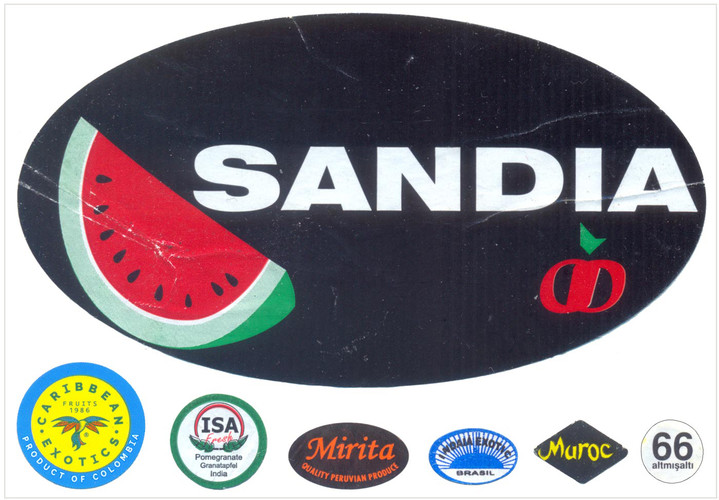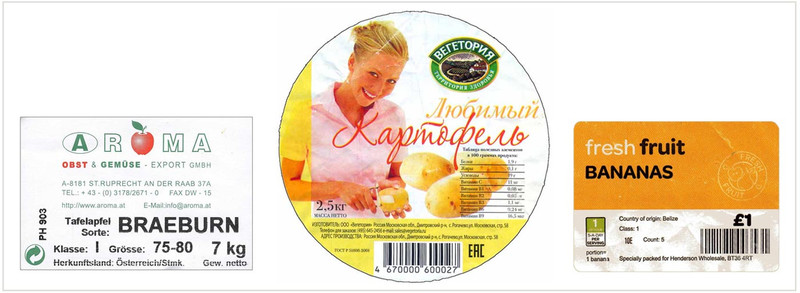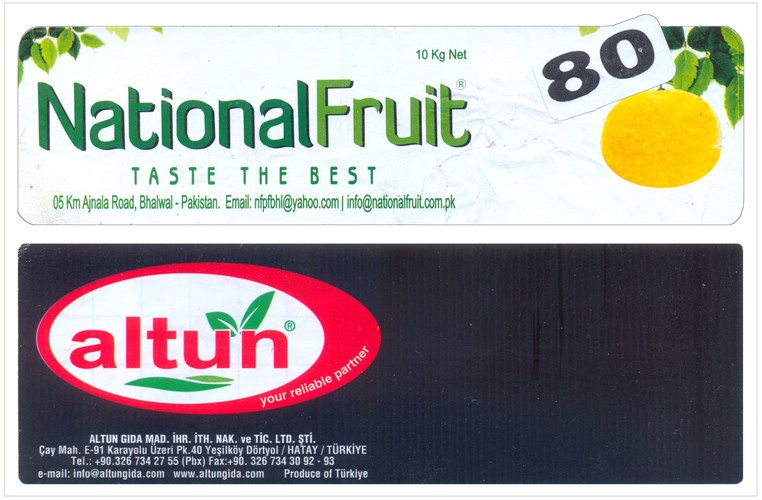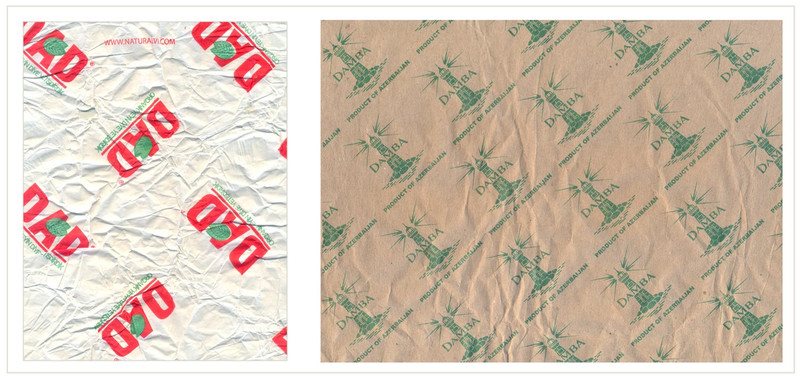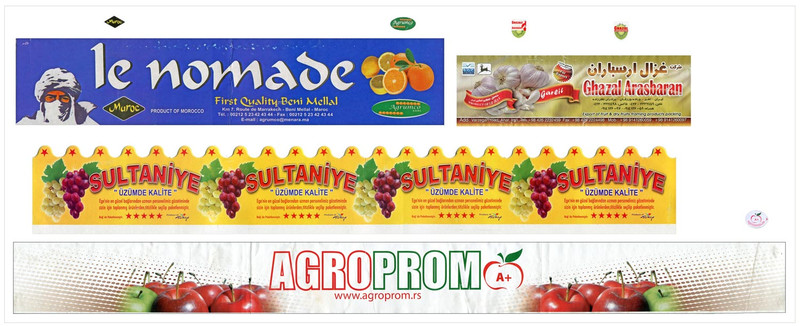Classes of fruit labels
Frutics usually starts as the collecting of fruit stickers. Pretty quickly the interests of the collector expand, when the same colorful images are found on the stickers on fruits packaging, on a variety of fruit hang-tags, on net-packaging bands, on fruit wrappers, on inserts of fruit boxes and on all other labels accompanying fruits and vegetables products. And then questions arise. Firstly, what kind of labels to collect for himself and what interests of his colleagues by hobby are? Secondly, how can we classify and systematize all this label diversity in order to understand what our fellow-collectors are talking about when there is a dialogue between them, especially when it comes to labels exchanging with other collectors?
After a brief survey analyses of the already accumulated labels in my own collection, I discovered that all this collected material falls into several types or classes by natural way.
In fact similar distribution onto several classes of the world's largest collection of fruit labels have been realized already by French collectors, and each class was given a name [1]. All this great number of labels (about 175 thousands), presented on the website of French collectors, was distributed into four groups: fruit stickers (130 thousands), fruit wrappers (about 35 thousands), fruit hang-tags or/and "cartonettes" (about 6 thousands) and, finally, labels for fruit mesh-packs (about 2 thousand).
Such a classification is obviously based on the nature of the material already accumulated in collection, quite naturally distributing among these four non-intersecting, i.e. do not alike each other, sets of fruit labels. Indeed, it’s impossible to confuse a sticker with a fruit wrapper or with labels hanging on clusters of fruits or hanging on net-packs of fruits. It is difficult to argue against such a natural and rather pragmatic classification.
However, in many collections there are examples of fruit labels that do not fit into the four classes mentioned. That is why, from my point of view, this classification needs to be somehow supplemented, clarified and detailed. So I will describe my version of the classification based on the above description, but with some necessary clarifications and additions. For the Russian-speaking readers, I will supplement the classification with equivalent Russian terminology. All these aspects will be the theme of this chapter, which narration could be now started.
So the whole set of fruit labels naturally falls down into several non-overlapping classes. Let's proceed to their consistent description.
The first class - the stickers - is the most numerous and the most popular among collectors class of fruit labels. The whole great set of stickers - the class of the stickers - quite naturally fall into three sub-classes.
The sub-class: the stickers directly on the fruits (stickers on fruits per se). These stickers are rather diverse by sizes and by shapes (i.e. by notching die).
Fig.1. Randomly selected set of labels with symmetric notching die. The size of the largest sticker is 11 cm in size across, the smallest is slightly less than 1 cm.
Fig.2. Randomly selected set of stickers with asymmetric notching die
Fig.3. One of the largest 30 cm long tape-shaped stickers used for melons pasting in around.
The sub-class: the stickers on the packaging of fruits. Most often, such labels are used in cases when it is impossible to paste stickers directly on the fruit per se, such as, for example, berries, mushrooms, dried fruits, nuts, greens, etc.
Fig.4. Randomly selected set of various stickers on packages with fruits when it is impossible to place stickers directly on fruits per se: dried fruits, greens, nuts, berries, cherry tomatoes, gherkins and mushrooms. The mushroom packaging sticker (in the lower right corner) is 11 cm in size across.
However, sometimes stickers occur for more or less massive packages of conventional large fruits such as apples, potatoes and bananas, shown, for example, in Fig.5 below.
Fig.5. Stickers for massive packages with large fruits: apples, potatoes, bananas. The size of central sticker is 10 cm in diameter.
The stickers on the fruit packages are much larger in sizes than the usual stickers on fruits, so that they are considerably more filled in with textual and graphic information then usual quite small classique stickers.
The subclass of stickers on card-boards or plastic fruit boxes. This is not well-known subclass, because the fruit stickers collectors are usually keen on finding new labels directly on the fruit and pay no attention at all to the walls of fruit boxes where these fruits and vegetables are located. Meanwhile, such stickers exist and could be found sometimes (see Fig.6.).
Fig.6. The stickers which was pasted on citrus fruit boxes. Both stickers are 15 cm long.
Even a cursory overview of the largest collections, presented in the Internet space, shows that most collectors include in their collections, as a rule, stickers on fruit per se and fruit packaging labels (see, for example, [1], [2], [3]). However, there are collections in which packaging stickers are not represented at all (see e.g. [4]). At least I could not find not any in that [4] collection. Stickers on the boxes are probably represented in collections, apparently, by single copies.
A distinctive feature of the class of the stickers is the presence of almost not removable glue, which does not lose its adhesive properties, on the back of each sticker. That's why they are also called self-adhesive labels.
For those who are keen on collecting fruit stickers exclusively, it's possible to suggest the rather convenient term "frusticks" (derived from the words "fruit" and "sticker"), i.e. the term frusticks means the hobby consisting in collecting only fruit stickers.
The second class - fruit wrappers - the next in size after the stickers class of fruit labels. This class - a whole lot of "fruit wrappers" — falls into two subclasses: the subclass of "wrappers" and subclass of "substrates".
A subclass of wrappers - the set of real “classic” fruit wrappers - that is probably the oldest class of fruit labels that appeared, it seems, even before then fruit stickers have appeared. According to some evidence on the Internet (see e.g. [5]), some amateur and very dilettantish collections began to take shape as early as 20s of the last century. So it follows that fruit wrappers could appear almost in the 1900s, although more accurate data haven’t been found yet.
In those years, only citrus fruits — mainly oranges — were usually wrapped in thin paper looked like waxed tissue paper, because of what collectors of fruit wrappers began to be called "agrumists" (agrumist [1] from french agrumes - citrus fruits). Over time, fruit wrappers began to be used not only for citrus fruits, but also for apples, pears, persimmons, etc. However, the terms “agrumist” and “agrumistics” associated with collecting of fruit wrappers are used until now.
Classic fruit wrappers are rectangular sheets of slightly waxed paper with sizes in the range of 20-28 cm, usually with colorful images of the same logos and brands of fruit companies as on fruit stickers. Sometimes wrapper drawings are accompanied by detailed textual information about the fruit company, but more often there is no textual information on the wrappers at all. In these cases, some collectors cut off the empty wide fields of such wrappers with scissors, leaving only their pictorial part. Such “circumcision” drastically and irreversibly reduces the value of such a fruit wrapper as a collectible. This is unacceptable almost the same as it would be unacceptable for philatelists or numismatists to cut and collect nice images from postage stamps or from banknotes.
Below in Fig. 7, randomly selected fruit wrappers are presented, illustrating the variety of their drawings from informative company logos to inexpressive dull images.
Fig. 7. A random set of fruit wrappers with drawings in range from informative company logos to expressionless images.
The subclass of fruit substrates emerged as a new subclass of fruit wrappers, due to the fact that some perishable fruits and specifically exotic tropical fruits in the ripe state do not tolerate full wrapping even in thin paper, but they nevertheless need to be isolated from each other, and also from the walls and bottom of fruit boxes. Therefore, a new variant of fruit wrappers - a paper-clad substrate - have become the most effective means of such partial isolation of fruits without wrapping them tightly into paper. Classical rectangular wrappers were not suitable for the role of such substrates, because their corner sections, convenient when used for wrapping fruits, turn out to be completely redundant and sticking out in all directions if used as substrates. Therefore, fruit substrates became made not rectangular, but rounded with a smooth or carved edges, and sometimes even with free shape edge. Here they are in Fig. 8.
Fig. 8. A random selection of fruit substrates (the smallest is 9.5 cm in diameter, the largest is about 21 cm)
In the subclass of fruit substrates, there is a little-known subgroup of rarely found “sheet-like” substrates which are sheets that are used as "between-layer" sheet substrates when to lay in a box, layer by layer, some fruits like apples e.g. The sizes of “sheet-like” substrate are slightly larger than sizes of the bottom of the fruit box, i.e. about 50-70 cm or so. Therefore, only fragments (see Fig.9) of such sheet substrates can be placed on the album, of course if it was possible to pull out them from the fruit-box and to cut carefully into suitable fragments.
Fig.9. Fragments of sheet-like substrates with dimensions of 17x21 cm and 28x21 cm, respectively
The distinctive feature of the class of fruit wrappers is their irremovable wrinkling. Trying to get rid of this feature of the wrappers is useless, and, apparently, is not worth it, since any thermal ironing e.g. with even a slightly heated iron can destroy the elasticity of the wrapper paper and harm its colorful layer. It is better smooth out them with palms on a flat surface and slightly "cure" them by gluing real tissue paper on the back of the wrapper along the tears, if any.
The third class – cartonettes. This set of fruit labels, most of which are made of thin cardboard, falls into two subclasses: the subclass of fruit hang-tags and the subclass of inserts. In the subclass of inserts, labels are sometimes found made of paper, not cardboard.
The subclass of fruit hang-tags is a set of cartonettes that are hung up either on bunches/clusters of fruits (e.g. of grapes or cherry-tomatoes) or on whole fruits (e.g. on pomegranate or pineapples), as well as on the bundles of some vegetables (like as e.g. green onions or asparagus).
Fig.10. Fruit hang-tags: on bunches of grapes (two labels on the top left), on clusters of cherry-tomatoes (two labels on the top right), on pineapples (extreme on the bottom left), on pomegranate (the second on the bottom left), on package of onion (penultimate bottom right) and on bundle of asparagus (extreme on the bottom right)
The distinctive feature of the subclass of "fruit hang-tags" is an indispensable hole in the label. These holes are cut down either at the stage of typograpic production of label, or are punched for special plastic hairpins (e.g. for pineapples) at the stage of sorting and packaging appropriate fruits.
The subclass of inserts consists of at least three subgroups of relevant labels: classic carton inserts into fruit packaging, service paper inserts into fruit packaging, and large carton inserts of ribbon-shaped inserts into fruit crates or boxes.
Classic carton inserts are shown in Fig. 11.
Fig. 11. Randomly taken sampling of classic carton inserts which are used in the very different packages of fruits and vegetables
Service paper inserts are usually used for internal production control of the manual packaging process on the conveyors of fruit companies. For the sake of cost reduction, they are made by improvised means (e.g. by xerox copying) or by typographic methods on inexpensive paper. As a rule, the personal number of fruit-packer's is shown on it either when typographically producing of insert or manually inscribing by pen when packing. Often they have service inscriptions made by hand. Randomly chosen samples of service paper inserts are presented in fig.12
Fig.12. Randomly chosen samples of service paper inserts used in fruits packing: see in COBRAS (a), (б), (в), (г)
Service paper inserts always are making of paper and always are one-sided ones.
Large ribbon-like inserts are either stacked around the perimeter (half-perimeter) of fruit crates and carton boxes, or attached by metal paper clips to their walls by special staplers. These sometimes rather long and big fruit labels are hard to place on album pages, unless to cut them into identical fragments like it is making e.g. for ribbon-like labels used for packing fruits into mesh packages (see below), or to fold them in half at least. Set of typical large ribbon-like inserts are shown in Fig.13 compared with stickers found in the same fruit boxes to make easier the comparison of their relative sizes.
Fig.13. Set of typical large ribbon-like inserts in comparison with stickers found in the same packages. The lower insert is
Large ribbon-like inserts are always one-sided and are made of fairly dense cardboard.
The fourth class - labels for fruit mesh-packs. This is a set of labels which are made mainly of plastic. Three subclasses could be marked out in this class definitely: subclass of net hangtags, subclass of bands, and subclass of glued-patches. The subclass of bands may include tape-like labels made of paper rather than plastic.
The subclass of net hangtags represents the set of labels not yet completely classified into different subgroups. Therefore, they will be further described and introduced into the classification gradually as they will be identified and classified as a subgroups.
Till now, it is possible to distinguish only two subgroups quite definitely among labels of net hangtags subclass: a subgroup of “wine-glass” labels and a subgroup of "ties". Set of typical “wine-glass” labels with illustration of their resemblance of real wine-glasses are shown in Fig.14.
Fig. 14. A random set of type "wine-glass" labels that, as could be seen, indeed look like wine glasses. Wine-glass like labels are double-sided sometimes, and information/pictures on them could be oriented both vertically and horizontally.
"Wine-glass" labels are single-sided and double-sided, and images or text on them can be oriented both vertically and horizontally.
The distinctive feature of the subgroup of “wine-glass” labels is existence of stems on two sides of label used for label's hanging on fruit mesh-packs.
Links:
[1] https://legufrulabelofolie.fr/
[2] http://fruitsticker.de/4images/data/media/85/big/39172.jpg
[3] http://www.riehl-collection.de/advancedsearch/pack
[5] https://www.dailymail.co.uk/news/article-2282381/The-futures-bright-thanks-orange-Pensioner-sells-collection-fruit-wrappers-fund-holiday-wife.html

